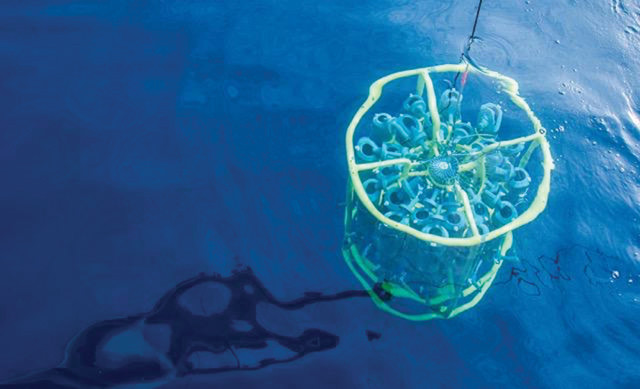
by Mary Caperton Morton Tuesday, August 16, 2016

Stephen Giovannoni's team samples for Pelagibacterales off Bermuda. Credit: Ben Temperton.
In the 1990s, researchers identified the most abundant group of organisms in the ocean as Pelagibacterales, a class of free-living bacteria that live in surface waters as a microscopic but major part of the phytoplankton community. Now, a new study suggests that Pelagibacterales could play an important role in the global climate cycle by producing dimethylsulfide (DMS), an organosulfur compound that stimulates cloud formation when it gets into the atmosphere.
Pelagibacterales are simple organisms, with streamlined genomes and compact cell structures that help them thrive even in the most nutrient-poor waters. “They can go a long way without much input,” says Stephen Giovannoni, a microbiologist at Oregon State University and an author of the new study, published in Nature Microbiology. Because it is so simple, microbiologists assumed it lacked the genomic software to make DMS. But “‘simplicity is the ultimate sophistication,’” Giovannoni says, quoting Leonardo da Vinci.
DMS is made from dimethylsulfoniopropionate (DMSP), a compound produced by phytoplankton as a byproduct of photosynthesis. The new study found that Pelagibacterales converts DMSP to DMS by way of two separate metabolic pathways. Both pathways were already known in other organisms, but always in conjunction with regulatory genes that turn the pathways on and off. Pelagibacterales, however, lack these regulatory genes, so “these pathways are … always on, always ready,” Giovannoni says.
Because Pelagibacterales are abundant in marine waters, the group could play a significant role in climate cycles. One hypothesis holds that phytoplankton blooms produce DMSP, which is converted to DMS by some microorganisms, which in turn increases nucleation of cloud droplets, thereby reducing the amount of sunlight that hits the ocean’s surface. More work will be needed to quantify Pelagibacterales’ contribution to this feedback loop, Giovannoni says, which could be an important step in improving the accuracy of climate models.
© 2008-2021. All rights reserved. Any copying, redistribution or retransmission of any of the contents of this service without the expressed written permission of the American Geosciences Institute is expressly prohibited. Click here for all copyright requests.